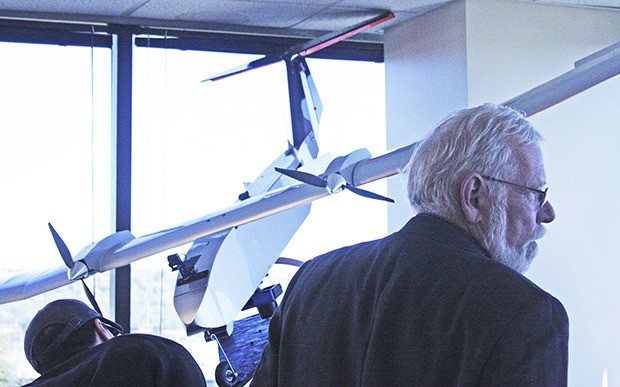Tom Ethen considers himself a pioneer in one of the country’s fastest-growing industries.
He represents a new kind of ambitious entrepreneur, one who is exploring ways to better manufacture and use unmanned aerial vehicles (UAVs), or drones, for everyday work and play.
The eye from the sky has few limitations, said the Spokane man.
“It has all kinds of applications, whether it’s precision agriculture or search and rescue,” said Ethen, a professional photographer, businessman and Air Force veteran. “Even with cattle … we can track an RFID (radio-frequency identification) chip and know exactly where a cow or bull is standing on a field.
“There are so many possibilities,” he said. “It is amazing.”
Ethen shared his ideas and his company’s $16,000 remote-controlled aircraft with colleagues at the Unmanned Systems Spring Forum, Trade Show and Networking Event at Kent’s CenterPoint Corporate Park last week.
Fountainhead Northwest LLC and the city of Kent hosted the event, which brought in 200 business leaders and vendors from Washington and the Northwest. The program included guest speakers from a wide range of UAV-affiliated fields. Groups toured the University of Washington Applied Physics Lab and participated in demonstrations at the Green River College flight simulator.
The city’s Economic and Community Development department is working with business and industry leaders and the colleges to explore potential partnerships to create a UAV technology hub in Kent.
According to industry leaders, the potential partnership would develop a “maker space” lab for the research, development and testing of UAVs in the hopes of enticing business leaders and industries to choose Kent as their business destination.
The Kent Valley already has a legacy in the UAV industry through Boeing’s space research and development, and advances made by other cutting-edge companies, like Blue Origin, which is working on launch vehicles to carry people to space.
“The talent and the technology are already here in the valley, and so are some of the buildings,” said Bill Ellis, a city of Kent economic development analyst. “But the question is: how do we build that industry going forward?”
Traditionally, unmanned aerial systems (UAS) have been military tools designed to perform intelligence, surveillance and reconnaissance missions. But with the Federal Aviation Administration (FAA) actively integrating these systems into the National Airspace System, the civilian and commercial use of drones should increase dramatically in the years ahead.
The market for small and medium drones likely will see the greatest growth in civil and commercial operations, industry leaders say. And Washington, like other states, stands to gain financially with job growth.
Industry leaders acknowledge that drones conjure up images of military use and war weaponry. And despite the public’s concerns about security and privacy, especially with domestic drones, the multipurpose craft is here to stay, industry leaders say.
“The applications are unlimited by your imagination,” said Alex Kaiser, with the Sandpoint, Idaho-based xCraft, which designs small drones.
Let’s count the ways
UAVs of all kinds are being used in a wide range of roles today.
They are ideal for crop monitoring, 3D mapping and imaging, surveying and surveillance, air quality control and pollution monitoring, and disaster assessment.
Agriculturally, UAVs can be an effective tool, Ethen said.
His company, NW Aerial Perspectives, offers camera-equipped UAVs, including the one displayed at the show, which features a 10½-foot wingspan and supports enough battery life to power a 2½-hour flight.
Ethen’s company specializes in UAV-assisted, precision agriculture and aerial videography, providing ranchers, farmers and others a cost-effective managerial eye from the sky.
“We can get multispectral photographs to detect the health of the plant, whether there is too much or too little water, whether there’s leaks in your irrigation system,” he said.
Such data and photography can help farmers better treat and protect their crops, perhaps saving billions of dollars in costs, Ethen said.
“We can help people save money … money spent in pesticides, fertilizers and water for farming,” he said. “If we can save them 1 percent, it’s a massive amount of money.”
UAVs also help monitor the environment, aiding in the protection of habitat and estuaries throughout the world.
Drones also can act as aerial construction and repair workers, help fight fires, log forests, support disaster relief, fight crime in the neighborhood, inspect oil rigs and deliver goods.
Career opportunities
Green River and the UW are preparing students for the UAV and UAS generation.
The UW has become a premier research institution with programs and expertise in UAS.
At Auburn, the Green River Aviation Technology Department launched a program in April that introduces students to the requirements of operating a UAV. The two-year applied science program should develop into a four-year degree option for students.
George Comollo, the aviation department’s senior instructor, is seeing a growing demand for UAV uses and for people capable of designing, building, repairing and running them.
Colin Nesbitt, who retired after 22 years in the Army, decided to return to college and get back into the aviation game. He was part of UAS surveillance missions in Iraq. After leaving the military, Nesbitt jumped at the chance to earn a UAS basic operator certificate at Green River. By the end of summer classes, he expects to have airline dispatch and UAS degrees, making himself even more marketable.
“It’s something I’ve always been interested in,” Nesbitt said. “For me, it’s a new career in systems I already know.”
Talk to us
Please share your story tips by emailing editor@kentreporter.com.
To share your opinion for publication, submit a letter through our website https://www.kentreporter.com/submit-letter/. Include your name, address and daytime phone number. (We’ll only publish your name and hometown.) Please keep letters to 300 words or less.

